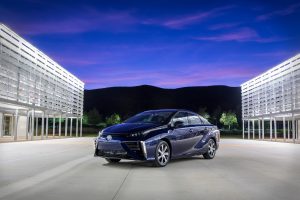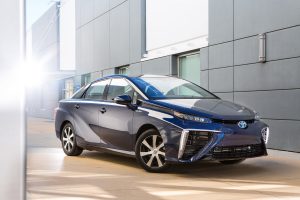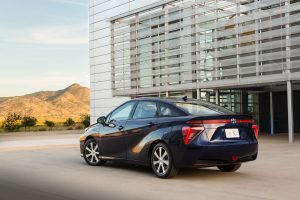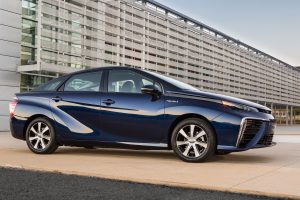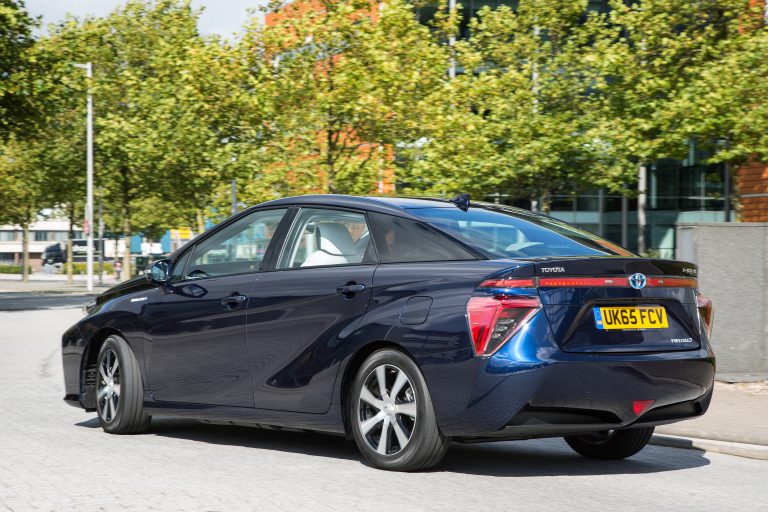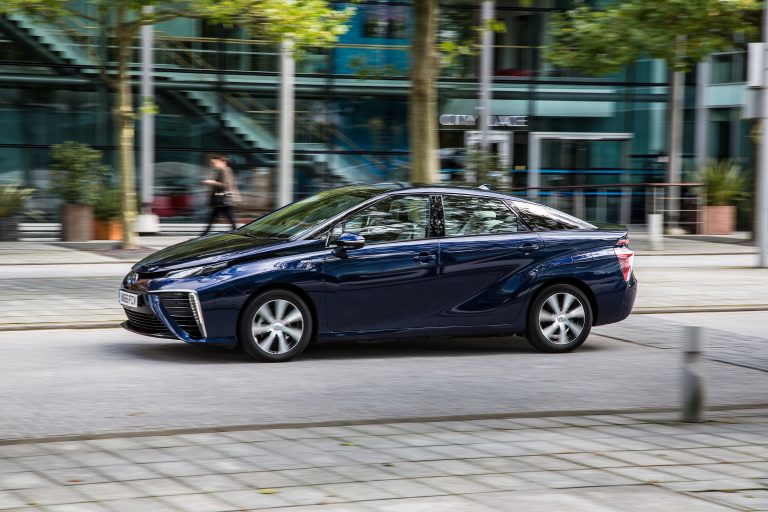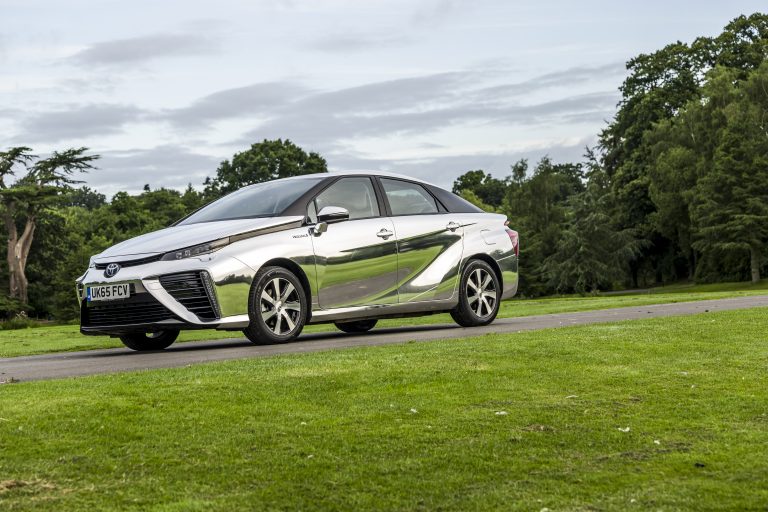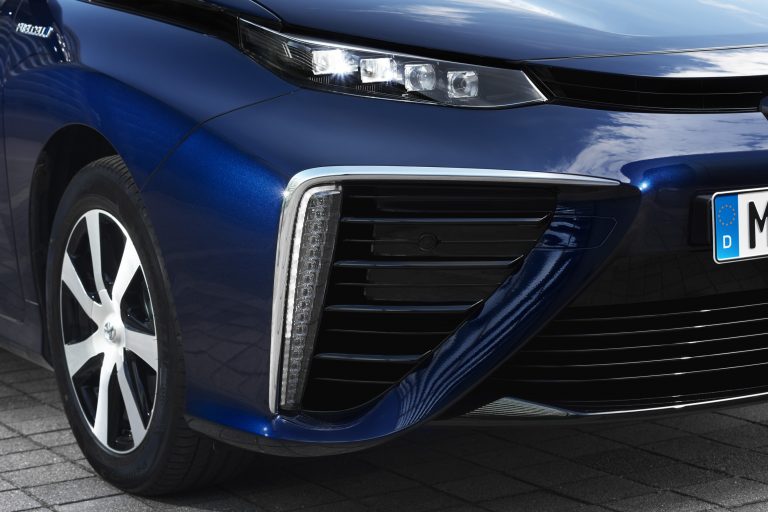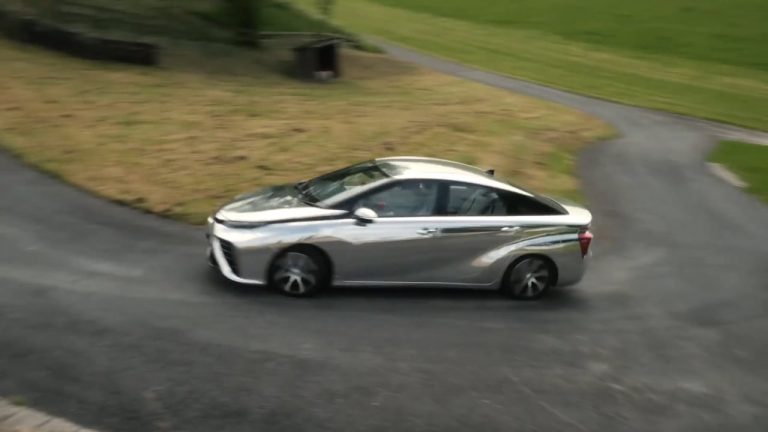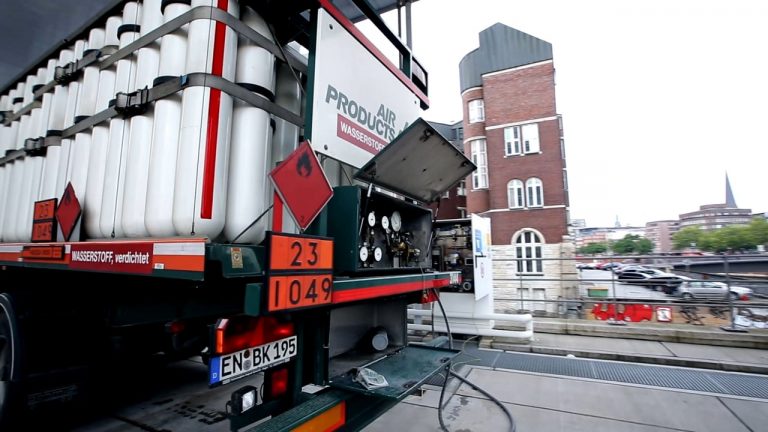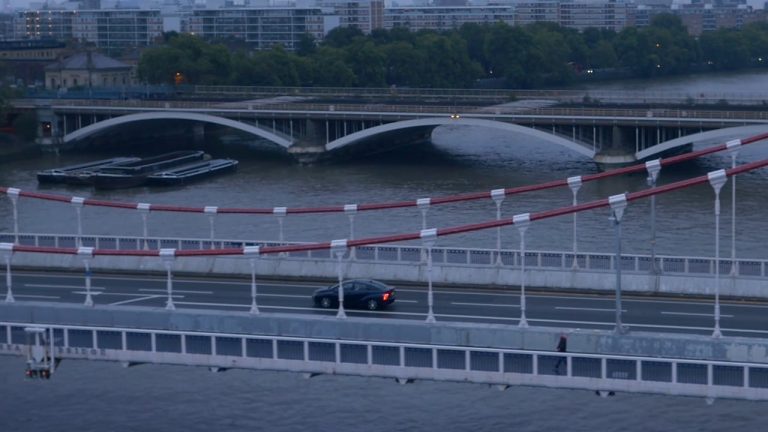Toyota Ushers In The Future With The Mirai Fuel Cell Car
Toyota will launch its all-new Mirai hydrogen fuel cell vehicle in Japan1 on 15 December, before introducing it in the UK and other selected European markets in September 2015.
Mirai – the name means future in Japanese – signals the start of a new age of vehicles. It uses hydrogen, an important future energy source, to generate electric power, delivering better environmental performance while giving customers the convenience and driving pleasure they expect from any car.
Mirai uses the Toyota Fuel Cell System (TFCS), which brings together fuel cell and hybrid technologies. It includes Toyota’s new, proprietary fuel cell stack and high-pressure hydrogen tanks. The TFCS is more energy efficient than internal combustion engines and emits no CO2 or pollutants when the vehicle is driven. A generous cruising range and a hydrogen refuelling time of around three minutes2 provide the same level of convenience as a petrol-powered car.
Mirai delivers everything expected of a next-generation car: an immediately recognisable design; an exhilarating drive that stems from the superior handling stability secured by the car’s low centre of gravity; and quiet but powerful acceleration delivered by the electric motor.
Hydrogen has the benefit of being able to be generated from many different natural sources and man-made by products – even sewage sludge. It can also be created from water using natural, renewable energy sources such as solar and wind power. When compressed, it has a higher energy density than batteries and it is relatively easy to store and transport. These qualities give it the potential to be used in the future for power generation and a wide range of other applications. FCVs can generate their own electricity from hydrogen, which means they can be a key contributor to making a future hydrogen-based society a reality and accelerating energy diversification.
European sales outline
Launch date: September 2015
Markets: UK, Germany and Denmark, followed by further national markets in 2017.
Expected volume: 50 to 100 cars a year in 2015 and 2016.
Price: UK pricing and equipment specification to be announced.
Production
Mirai is manufactured exclusively at Toyota’s Motomachi plant in Japan.
OUTLINE VEHICLE DETAILS
1. Environmental performance and convenience
Mirai uses the Toyota Fuel Cell System, which fuses fuel cell and hybrid technologies.
The TFCS is more energy efficient than internal combustion engines, gives better environmental performance with no CO2 or other pollutants when the car is driven, and has the same convenience and autonomy as petrol-powered vehicles, with a refuelling time of around three minutes2.
The system uses components Toyota has developed itself, including the Toyota FC (fuel cell) Stack, FC boost converter and high-pressure hydrogen tanks.
Toyota Fuel Cell Stack
The new Toyota FC stack has a maximum power output of 153bhp (114kW). The efficiency of its electricity generation has been improved by using 3D fine mesh flow channels3 – a world first – which ensure uniform generation on the cell surfaces. This has helped give the FC stack compact dimensions, a high level of performance and a world-leading4 power output density of 3.1kW/L, a figure 2.2 times greater than that achieved in Toyota’s previous FCHV-adv model.
The amount of water on the fuel cell electrolyte membranes has a substantial influence on electricity generation efficiency. The amount of water is controlled using an internal circulation system to carry water produced in the electricity generation process. This makes the Toyota FC Stack a world-leading4 system that, unlike those used in all other previous Toyota fuel cell vehicles, doesn’t require a humidifier.
FC boost converter
A new, compact, high-efficiency, high-capacity converter has been developed to boost the power generated in the Toyota FC Stack to 650 volts. Increasing the voltage has made it possible to reduce the size of the electric motor and the number of fuel cells, leading to a smaller FC system that gives higher performance with reduced costs.
High-pressure hydrogen tanks
The fuel tanks have a three-layer structure made of carbon fibre-reinforced plastic and other materials, and they store hydrogen at very high pressure – 70MPa, or approximately 700bar. Compared to the tanks used on the previous Toyota FCHV-adv, storage has been increased by around 20 per cent, while weight and size have been reduced to a world-leading4 5.7 weight-per cent5.
2. Designed and equipped for safety
FCV safety measures
Mirai was designed with safety as a top priority, with the fundamental approach of ensuring the hydrogen does not leak. In the unlikely event a leak does happen, measures are in place to ensure immediate detection, stoppage of the flow and the prevention of any build-up of hydrogen in the car.
Steps taken to achieve this include: –
- Development of high-pressure hydrogen tanks with excellent permeation prevention performance, strength and durability.
- Hydrogen sensors to provide warnings and shut off the tanks’ main stop valves.
- The location of the tanks and other hydrogen-related parts outside the cabin, so that if there is a leak, the hydrogen will disperse easily.
Using features such as a body structure that efficiently disperses and absorbs impact energy across multiple elements provides excellent protection for the Toyota FC Stack and hydrogen fuel tanks in front, side or rear impacts.
The Toyota FC Stack’s frame is made from a new thermoplastic carbon fibre-reinforced plastic which is light, strong and easy to mass produce. This protects the FC stack by absorbing impact shock from bumps and other road interference.
Advanced safety equipment
Mirai is available with a full range of advanced safety equipment. Standard features include:
- A pre-collision system with millimetre-wave radar which helps prevent collisions, or reduced damage in an impact by triggering driver alerts and, if a high collision risk is detected, brake control.
- A lane departure alert which uses a camera to detect white or yellow lane markings and warns the driver if the car is about to deviate from its lane.
- Drive-start Control limits sudden starts or acceleration when making gear shifts.
- A blind spot monitor which uses radar to detect vehicles in adjacent lanes and helps the driver with rear-view checks when changing lanes.
3. Instantly recognisable design
Exterior
Toyota has used a new technique in creating Mirai’s frontal design, emphasising the left and right side grilles through which air is drawn to supply oxygen and to cool the FC system. This new look emphasises the car’s individuality.
The elegant side profile evokes the lines of a flowing water droplet, capturing the way the car draws in air and emits water. The roof side rails and the bonnet are styled to look as though they pop out of the body, giving the impression of a low-to-the-ground, futuristic vehicle.
The rear profile has a trapezoidal shape that extends from the licence plate surround to the bottom corners of the bumper and out towards the wheels. The top of the bumper express width and a stable stance, while also giving an agile, clean impression of air passing through and underneath the bumper.
The headlights exhibit high-tech luxury and sophistication with a novel, ultra-thin profile and an in-line arrangement of four LED lights, together with visible heat sinks and other optical elements. The front turn signals and clearance lights are separate from the headlights, contributing to the slim profile, while merging with the side grilles. This creates an advanced, clean, aerodynamic design that helps improve airflow over the car.
Mirai runs on 17-inch aluminium wheels which have been made lighter by the use of an engraving process6. Six body colours will be available.
Interior
Mirai’s sophisticated cabin space features soft padding on door trims and other interior surfaces, and a high-luminance silver finish throughout.
The front seats use an integrated cover/seat foaming process7 to provide better body fit and hold. Eight-way power adjustment allows the ideal seating position to be set and both driver and front passenger seats have a motorised lumbar support.
The central meter cluster on the top of the instrument panel features a speedometer and a multi-information display presented on a high-definition 4.2-inch liquid crystal TFT screen. The driver can change the display using controls on the steering wheel.
Seat heater switches and other functions are operated using electrostatic controls that need just a light touch on the flat air conditioning control panel.
Features that help make life on board comfortable come as standard, such as a heated steering wheel; seat heaters with two temperature settings, providing instant warmth while using less power; and fully automatic air conditioning with independent left and right temperature control, eco mode operation and Nanoe8 air purification technology.
Customers can choose from three interior colour choices, including Warm White.
Thanks to the design and packaging of the fuel cell system battery, there is ample space in the boot.
4. Handling stability and outstanding quietness
The high-output Toyota FC Stack and optimal battery control drive the electric motor, ensuring powerful responsiveness at all speeds. The system provides an immediate increase in torque the moment the accelerator is pressed and smooth powerful acceleration thereafter.
Locating major parts such as the FC stack and high-pressure hydrogen tanks centrally beneath the vehicle floor gives improved handling stability and ride comfort, as well as a low centre of gravity and good front/rear weight distribution. Mirai also benefits from a highly rigid body, with extra rigidity around the rear suspension.
The full underfloor cover and aerodynamically designed clearance lights reduce wind resistance and contribute to the car’s fuel efficiency and handling stability. Aero fins added to the side of the rear combination lights also have a positive impact on straight-line driving stability.
The electric motor drive operates with outstanding quietness at all speeds. Cabin quietness is further supported by the full sealing of all body parts, strategic deployment of sound absorbing and insulating materials around the cabin and use of noise-reducing glass for the windscreen and door windows.
The driver can make us of Bs (brake support) mode for efficient use of the car’s regenerative braking function, increasing braking performance when needed, for example when negotiating a long downhill section of road.
TOYOTA MIRAI vs FCHV-adv TECHNICAL SPECIFICATIONS
This table provides technical specifications for the Toyota Mirai with comparative values for the previous SUV-based FCHV-adv fuel cell vehicle. Toyota previously made FCHV-adv available in very limited numbers as a lease vehicle.
| FUEL CELL STACK |
TOYOTA MIRAI |
TOYOTA FCHV-adv |
|
| Type |
Polymer electrolyte fuel cell |
Polymer electrolyte fuel cell |
|
| Humidification system |
Internal circulation |
External humidifier |
|
| Max. output (bhp/kW) |
153/114 |
121/90 |
|
| Volume-power density (kW/l) |
3.1 |
1.4 |
|
| Mass-power density (kW/kg) |
2.0 |
0.83 |
|
| Volume (l) |
37 |
64 |
|
| Weight (kg) |
56 (cells + fastener) |
108 |
|
| Cells | Number in one stack |
370 (single line stacking) |
400 (dual line stacking) |
| Thickness (mm) |
1.34 |
1.68 |
|
| Weight (g) |
102 |
166 |
|
| Flow channel |
3D fine mesh |
Straight channel |
|
| Separator material |
Titanium |
Stainless steel |
|
| MOTOR | |||
| Type |
AC synchronous electric generator |
AC synchronous electric generator |
|
| Max. output (bhp/kW) |
152/113 |
121/90 |
|
| Max. torque (Nm) |
335 |
260 |
|
| HIGH-PRESSURE HYDROGEN TANKS | |||
| Number of tanks |
2 |
4 |
|
| Type |
Type 4 |
Type 4 |
|
| Structure |
3-layer |
– |
|
| Materials |
Inner layer – plastic Middle layer – carbon fibre-reinforced plastic Surface layer – plastic |
– |
|
| Fuel |
Compressed hydrogen |
Compressed hydrogen |
|
| Max. filling pressure (MPa) |
87.5 |
70 |
|
| Nominal working pressure (MPa) |
70 |
– |
|
| Storage density (wt%) |
5.7 |
4.7 |
|
| Total internal volume (l) |
122.4 (60 front, 62.4 rear) |
156 |
|
| Hydrogen storage mass (kg) |
Approx. 5.0 |
– |
|
| Combined tank weight (kg, not including valve) |
87.5 |
– |
|
| Refuelling time (min)3 |
Approx. 3 |
– |
|
| BATTERY | |||
| Type |
Nickel-metal hydride |
Nickel-metal hydride |
|
| FUEL CELL BOOST CONVERTER | |||
| Number of phases |
4 |
– |
|
| Max. output voltage (V) |
650 |
– |
|
| Volume (l) |
13 |
– |
|
| PERFORMANCE | |||
| Cruising range (miles – approx.. figure prior to homologation) |
300 |
– |
|
| Fuel consumption |
Tba |
– |
|
| Max. speed (mph) |
111 |
96 |
|
| Acceleration 0-62mph (sec) |
9.6 |
– |
|
| Acceleration 25-44mph (sec) |
3.0 |
– |
|
| Cold start temperature tolerance (deg C) |
-30 |
-30 |
|
| DIMENSIONS AND WEIGHTS | |||
| Length (mm) |
4,890 |
4,735 |
|
| Width (mm) |
1,815 |
1,815 |
|
| Height (mm) |
1,535 |
1,685 |
|
| Wheelbase (mm) |
2,780 |
– |
|
| Track – front (mm) |
1,535 |
– |
|
| Track – rear (mm) |
1,545 |
– |
|
| Min. ground clearance (mm) |
130 |
– |
|
| Interior length (mm) |
2.040 |
– |
|
| Interior width (mm) |
1,465 |
– |
|
| Interior height (mm) |
1,185 |
– |
|
| Seats |
4 |
5 |
|
| Kerb weight (kg) |
1,850 |
1,880 |
|
| Coefficient of drag (Cd) |
0.29 |
– |
|
1 Sales will begin in areas where hydrogen refuelling stations are in place.
2 As measured by Toyota when refuelling at a hydrogen station supplying hydrogen at a pressure of 70MPa under the SAEe J2601 Standard conditions (ambient temperature: 20°C, hydrogen tank pressure when fuelled: 10MPa). Time will vary depending on hydrogen fuelling pressure and ambient temperature.
3 Channels arranged in a fine, three-dimensional lattice structure. This enhances dispersion of air (oxygen), thereby enabling uniform generation of electricity on cell surfaces.
4 As of November 2014, according to Toyota Motor Corporation research.
5 Hydrogen mass per tank weight.
6 This manufacturing process to reduce the weight of aluminium wheels involves shaving metal from the intersecting line between the disc and rim. This reduces individual wheel weight by approximately 500 grammes.
7 Previously seat pads were moulded separately then covered. In the foaming process the seat covers are place into moulds, into which urethane material is injected directly.
8 A trademark of Panasonic Electric Works Co. Ltd.

